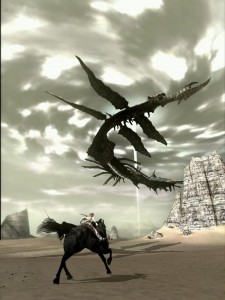I went to an old work acquaintance’s apartment last night for the first time (which I suppose means that we are now upgraded to “new friend” status) and I had a fun time being the least terrible at Mario Kart 8‘s new wild 200cc class. Like pretty much all of the Wii U’s best titles, it is a game best played in the same room with others. Even if Nintendo realized what the internet was and added competent voice chat, there is an added element when sharing a couch in the same physical space as other humans; turning and shouting at a wild moment, deciding what mode to play, taking a break together, and sensing the tension and frustration in the people sitting beside me all seem to be factors built into the gameplay of titles like Mario Kart 8, Super Smash Bros., and Game & Wario. And while these games share this strong local multiplayer factor and a strong “Nintendo” feeling, they – and no other Nintendo game really – seems to reflect the singular voice and intention of just one mind. Even early Nintendo games or the strongest of their strongest work helmed by a genius such as Shigeru Miyamoto feel like games that have come from Nintendo and not one person’s vision. Put another way through an example, I would say that Miyamoto and in turn Aunoma ultimately serve Zelda rather than the other way around.
This is not always the case in gaming as a few voices have shot their way to an elusive position of creative control during the explosive and unstable beginnings of game design. I do not have the gaming history knowledge of some of the other members of LCom, so I am sure that there are a large number of significant names I will not mention, but whatever, that is what the comments are for!
Hideo Kojima is a man who had very lucky timing. The Metal Gear games certainly have strong design, but they have also served as a platform for Kojima’s interesting, but incredibly bloated ideas. His early success in the landscape of gaming ensured his creative freedom, no matter how ludicrous and oblivious. But, for all the madness inherent in those games and as far as they may fall from my interests and what I can stand in a gaming narrative, I have great respect for them. They are games that seem to be unmistakably a product of Kojima’s mind. They impress me simply by existing. As more people are required to bring a creative product to fruition and as more money becomes involved, it becomes more and more difficult from a practical and emotional standpoint for a single creative vision to be a driving force. This has been a struggle since film’s inception as well, the most comparable creative medium in terms of number of people and amount of money involved.
As game design continues to find itself through fits of financial successes, market research, indie gaming, and the slow emergence of serious critique, singular creative voices are starting to stray from the Kojima style of “anything goes as long as there is a functional foundation”. Fumito Ueda showed off two strong works that were distinctly his own and were both distinct expressions of gaming, using mechanics, atmosphere, world design, premise, and music to surround focused themes. In short, Ico and Shadow of the Colossus were games that said something. They were projections of a single person’s vision.
Indie gaming has helped immensely to shine a spotlight on this relationship. Competent and popular visions like Fez and Braid made it more common to associate a single name with game ideas much like one would do with music, literature, or film. Jonathan Blow, the designer of the latter game decided to follow up his philosophical 2D side-scrolling platformer with a 3D first-person exploration puzzle adventure game The Witness due out this year. This method of resisting the compulsion to just make a lazy sequel like many rich publishers decide to pursue is an encouraging emerging trend. In the AAA scene, Ueda was the biggest recent name to do this until The Last Guardian collapsed upon itself and became whatever tangled mess is still apparently in development. Fortunately, Hidetaka Miyazaki has stepped up to continue to show the benefits to this method. While I am only familiar with Bloodborne and while all his games share many traits, detaching the creative process from the expectations of sequels has allowed Miyazaki to more clearly output his distinct visions.
Games are complicated and difficult to create. Not only because of the time, money, and manpower needed, but because of the unknown complexities of its practically still brand new form. The more that strong single creative voices are able to harness a team to produce their specific vision, the more we will be able to understand gaming’s potential as an art form.
Or maybe you disagree, fine readers. Do you think games are too big to reflect a single person’s vision? Are there games and people too important to have not mentioned here? Engage with your singular vision for what a comment to this article should look like.

